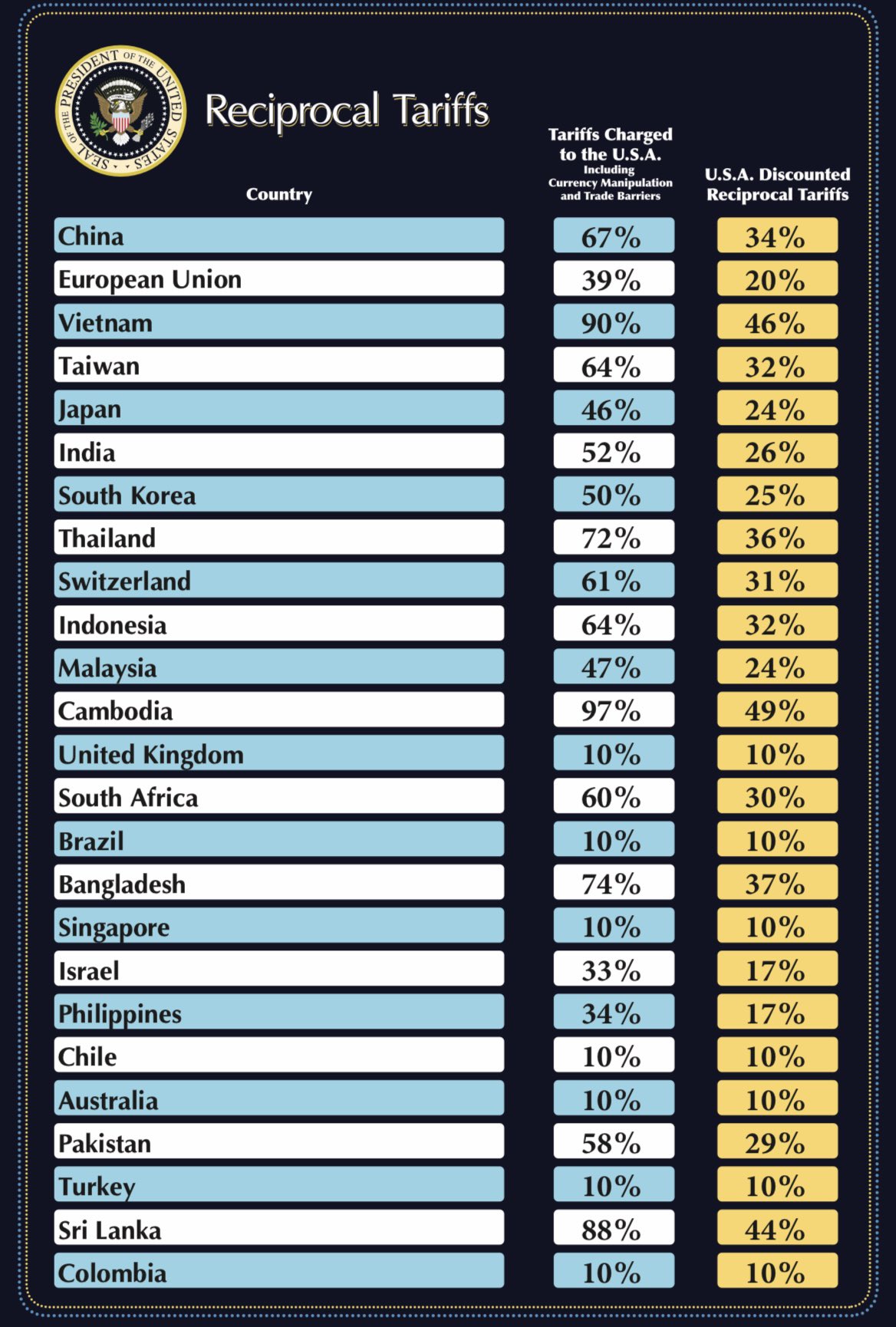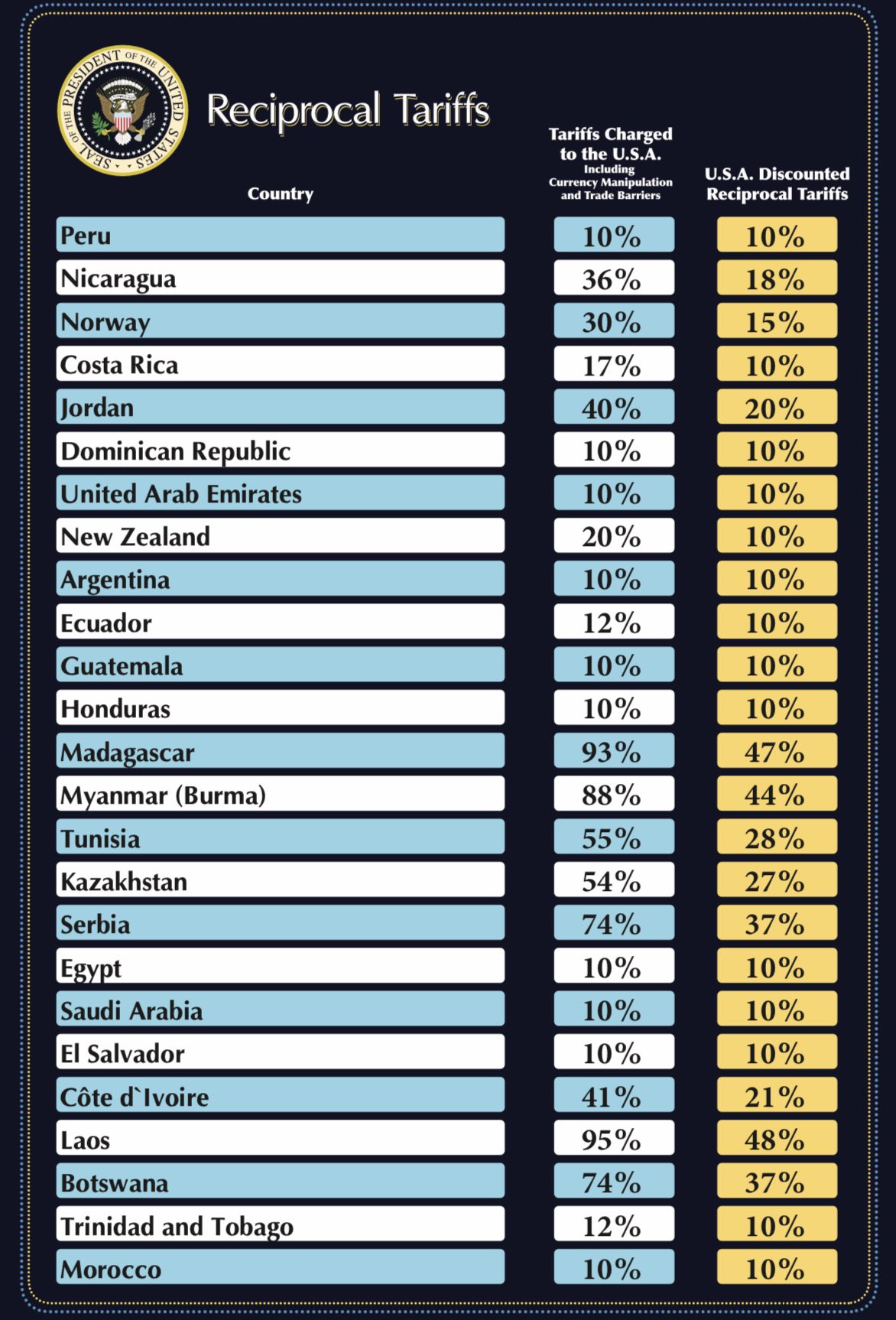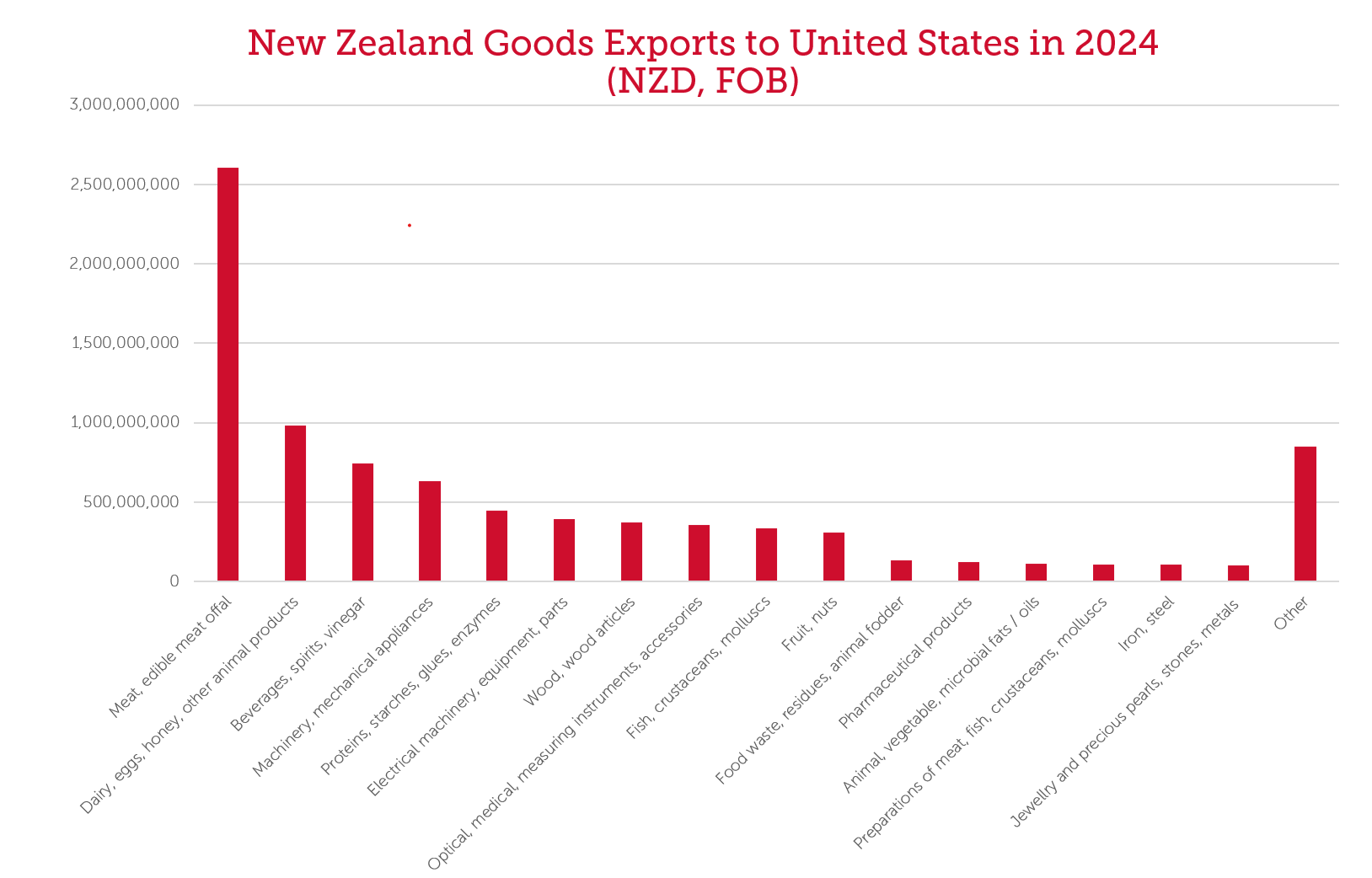What happened?
Earlier today, President Trump declared a national emergency and announced sweeping tariffs on United States (US) imports, including a 10% universal tariff on all imports, including those from New Zealand, as part of measures to restore US economic sovereignty.
This alert summarises the US’s key announcements and provides practical recommendations for New Zealand exporters eager to safeguard their US market positions.
Who needs to read this alert and why?
This alert should interest New Zealand exporters, investors, logistics services providers, trade associations, businesses, government officials and analysts involved in the United States – New Zealand trade relationship.
President Trump’s “Liberation Day” announcements
Earlier today, President Trump declared a national emergency due to foreign trade and economic practices perceived to be undermining the US economy and national security. The follow specific measures were announced to restore US economic sovereignty and address trade imbalances:
- Universal tariffs: A 10% tariff will be imposed on imports from all countries, including New Zealand, from 12:01am EDT on 5 April 2025. This tariff will apply in addition to any tariff already payable.
- Reciprocal tariffs: Countries with the largest trade deficits with the US and those perceived to be imposing significant barriers to US imports will face higher individualised tariffs starting at 12:01am EDT on 9 April 2025 (see Figure 1). Of note, the following tariffs will be imposed on imports from China (34%), European Union (20%), United Kingdom (10%), and Australia (10%).
- Modification authority: Tariffs can be increased if trading partners retaliate or decreased if they align with US economic and national security policies.
- Exemptions: Certain goods, including steel/aluminium articles, autos/auto parts, pharmaceuticals, semiconductors, and energy, are exempt from the reciprocal tariffs.
- Canada and Mexico: Existing fentanyl/migration orders remain in effect, with USMCA compliant goods continuing to face a 0% tariff.
The President has justified his measures by invoking his authority under the International Emergency Economic Powers Act of 1977 (IEEPA). Further details of President Trump’s announcements are available here.
During today’s public broadcast, President Trump also announced that the US will impose a 25% tariff on all automobile imports starting on 3 April 2025, and on certain automobile parts no later than 3 May 2025. These tariffs will be implemented on national security grounds under section 232 of the Trade Expansion Act of 1962. Based on recent developments, we anticipate that the US administration may soon announce further trade-related investigations, which could lead to the introduction of new tariffs on imports from New Zealand and other countries in the near future. Sectors to be targeted are likely to include pharmaceuticals, semiconductors and agricultural products.”
Figure 1 – Reciprocal Tariffs


Potential implications for New Zealand companies
Goods exporters
The US market is the second most important destination for New Zealand goods exporters, accounting for about 13% of New Zealand's total exports in 2024. Last year, New Zealand exported nearly NZD9 billion worth of goods to the US, including meat, dairy products, wine, and machinery. From 12:01am EDT on 5 April 2025, all US imports from New Zealand will face a 10% tariff, initially payable by the US importer but potentially passed on to another party, such as the exporter, through a contract.
Figure 2

The 10% US import tariffs will raise the cost of New Zealand goods in the US market, making them less competitive compared to local products or those from countries with lower tariffs. This could decrease demand for New Zealand exports, potentially reducing sales and impacting the revenue of New Zealand exporters. However, some New Zealand exporters might find that today's announcements actually improve their relative position in the US market, as their primary export competitors are being hit with even higher US import tariffs than New Zealand.
- New Zealand companies that export to the US via foreign subsidiaries or contract manufacturers will also need to check the US reciprocal tariff imposed on their country of export. Those exporting goods from China will now face a minimum US import tariff of 54%.
Goods importers
Unlike some countries, New Zealand is unlikely to retaliate against reciprocal tariffs by imposing new import tariffs on US goods. Instead, New Zealand is more likely to respond via bilateral discussions and multilateral channels, seeking reconsideration, exemptions, or resolutions without escalating tensions.
Listed companies
New Zealand listed companies will need to be mindful of their continuous disclosure obligations, particularly those that have given earnings guidance. If the effect of the tariffs on the issuer is non-public material information (e.g. it causes a material deviation to their earnings guidance or market expectations of the issuer’s performance), then NZX disclosure will be required. Therefore, Boards and management will need to be actively considering and monitoring this issue.
Investors
Today’s announcements will introduce significant uncertainty and volatility into the market, affecting stock prices and investment decisions. Investors might become more cautious, reconsidering their portfolios and delaying or cancelling planned investments due to the increased risk and potential financial implications.
Additionally, cross-border investments could face more scrutiny and regulatory hurdles, complicating the investment landscape. Those involved in deals should ensure their due diligence processes interrogate the potential impact of Trump's announcements on targets with international business, especially if that business involves exporting to the US.
Recommendations
New Zealand exporters seeking to protect their market positions in the US can take several practical steps, including:
1. Act now: All US imports from New Zealand will face a 10% tariff from 12.01am EDT on 5 April 2025.
2. Determine tariff impact: Identify which of your export products are affected based on their HS codes. Determine the applicable US import tariff and assess the cost implications for the duty payer.
- Applicable tariff: For complex processed goods, determining the applicable tariff can be difficult, especially for products with international supply chains. Their HS code and origin depend on factors such as materials, processing methods, and transformation levels across countries. Apply US preferential and non-preferential rules of origin to establish the correct origin for US Customs purposes.
3. Determine tariff responsibility: Identify who is contractually responsible for paying the new tariff - whether you or your US customer. Review your supply contract to determine if renegotiation is possible or required in these circumstances.
- Contract review: This will involve assessing key clauses on pricing, cost allocation, Incoterms, force majeure, changes in law, price adjustments, assignment, termination, and dispute resolution. Keep in mind that courts typically reject arguments for non-performance under force majeure or commercial impracticability due to tariff-related price increases.
4. Adjust pricing strategies:
- Reassess pricing models: Consider whether to pass on the tariff costs to your US customers, absorb the costs, or adjust your pricing models. Offering alternative value propositions can help maintain competitiveness.
- Monitor and respond to market trends: Stay agile by continuously assessing competitor pricing and adjusting strategies based on shifts in the US market and customer demand.
5. Explore alternative trade routes: If necessary, carefully consider alternative strategies for avoiding the new tariffs, including:
- Duty drawbacks or exemptions: Some US importers may qualify for tariff exemptions or refunds under specific schemes, allowing them to recover duties paid.
- Use US Free Trade Zones (FTZs): Consider storing goods in one of the 261 US FTZs to delay or avoid tariffs. Inventory can be held near US ports or customers, re-exported without tariffs, or have tariffs applied only to the final products when entering the US market.
- Consider third-country processing: Export semi-finished goods to a country with lower US import tariffs for final processing before entering the US to potentially reduce costs. Initially, all imports will be subject to the US’s universal tariff, but this is likely to change as trading partners negotiate by demonstrating alignment with US economic and national security policies.
- Expand digital and e-commerce channels: Direct-to-consumer sales (e.g., through platforms like Amazon or Shopify) may help reduce US import duty liability.
6. Strengthen US market position:
- Focus on value-added or premium segments: Competing on quality, sustainability, and unique product attributes can justify higher prices and maintain market appeal.
- Renegotiate supply contracts with care: New Zealand exporters should ensure that tariff responsibilities are clearly defined, include pricing adjustment clauses as appropriate, and ensure strong dispute resolution mechanisms.
7. Diversify export markets:
- Reduce dependence on the US: Consider strengthening trade relationships with other markets where tariffs and market conditions may be more favourable or stable.
8. Engage with New Zealand Government and industry groups:
- Provide insights to Government: Share intelligence and impact assessments with the Ministry of Foreign Affairs and New Zealand Trade and Enterprise. These agencies lead efforts to negotiate improved market access for New Zealand exports and advocate for broader business interests. Ask to join their network of interested stakeholders.
- Collaborate for support: Work with supply chain partners, industry bodies, and advisors to advocate for exemptions, alternative agreements, or compensation measures, highlighting the importance of New Zealand products and their competitive edge.
With careful planning, New Zealand exporters can navigate these complexities, protect their market positions, and capitalise on new opportunities.
Questions?
If you have any questions about US tariff developments, please contact one of our experts.





